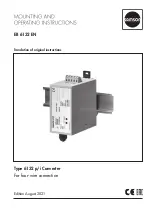
DS245F4
67
CS8420
13.5
Hardware Mode 4 Description
(Transceive Data Flow, No SRC)
Hardware mode 4 data flow is shown in
. Audio data is input via the AES3 receiver, and routed to
the serial audio output port. Different audio data synchronous to RMCK may be input into the serial audio
input port, and output via the AES3 transmitter.
The channel status data, user data, and validity bit information are handled in two alternative modes: 4A
and 4B, determined by a start-up resistor on the COPY pin. In mode 4A, the received PRO, COPY, ORIG,
EMPH, and AUDIO channel status bits are output on pins. The transmitted channel status bits are copied
from the received channel status data, and the transmitted U and V bits are 0.
In mode 4B, only the COPY and ORIG pins are output, and reflect the received channel status data. The
transmitted channel status bits, user data, and validity bits are input serially via the PRO/C, EMPH/U, and
AUDIO/V pins.
shows the timing requirements.
The APMS pin allows the serial audio input port to be set to master or slave.
If a validity, parity, bi-phase, or lock receiver error occurs, the current audio sample is passed unmodified
to the serial audio output port.
Start-up options are shown in
, and allow choice of the serial audio output port as a master or slave,
whether TCBL is an input or an output, the audio serial ports formats, and the source of the transmitted C,
U, and V data.
The following pages contain the detailed pin descriptions for Hardware mode 4.
AES3
Encoder
& Tx
Serial
Audio
Output
AES3 Rx
&
Decoder
C & U bit Data Buffer
RXP
RXN
OLRCK
OSCLK
SDOUT
TXP
TXN
RMCK
RERR
COPY ORIG EMPH/U AUDIO/V
TCBL
DFC0
DFC1
VD+
H/S
Power supply pins (VD+, VA+, DGND, AGND) & the reset pin (RST) and the PLL filter pin (FILT)
are omitted from this diagram. Please refer to the Typical Connection Diagram for hook-up details.
VD+
Serial
Audio
Input
ILRCK
ISCLK
SDIN
PRO/C
APMS
Figure 27. Hardware Mode 4 - Transceive Data Flow, Without SRC
















































